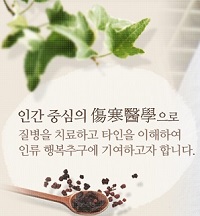 ISSN : 2287-8696
ISSN : 2287-8696
Tourette Syndrome Treated with Hoeyeoksan Based on Shanghanlun Provisin 318: A Case Report
Abstract
- keywords
- Disease Pattern Identification Diagnostic System, Hoeyeoksan (回逆散), Huini-san, Shanghanlun, disease, Tourette syndrome
Reference
1.Cho SC. The concept of pediatric psychological disease. Seoul:Seoul National University Press, 1999:183,193-6,198.
2.Cho HE, Kim HS. A case study of sandplay therapy for a child with tic disorder. The Journal of Play Therapy 2014 ; 18(2) : 91-107.
3.James Morrison. Easy learning DSM-Ⅴ;guideline for clinicians. Seoul:Sigma Press. 2016:2-3.
4.Park WM, Kim CH. Clinical neuropsychopharmacology. 2nd ed. Seoul: Sigma Press. 2014:652-8.
5.Chung SJ, Lee JS, Yoo TI, Koo YJ, Jeon SI, Kim BS, Hong KE. Development of the korean form of yale global tic severity scale:a validity and reliability study. J Korean Neuropsychiatr. 1998 : 37(5) ; 943.
6.Lee IS, Yoon JY, Han JK, Kim YH. Traditional Chinese Medicine in treatment of Tic disorder. Journal of Haehwa Medicine. 2013;22(1):91-104.
7.Sim M, Lee JH, Kim TH, Lyu YS, Kang HW. A study on oriental medical understanding of tic disorders (within Dong-yui-bo-gam book). J Orient Neuropsychiatr. 2007;18(2):1-12.
8.Lee SJ, Lim JE. A diagnostic system and clinical application based on Shanghanlun six meridian patterns and provisions. Seoul: KMediACs publishing house. 2013.
9.Wei YM. Children's tic disorder. Seoul: JNC community. 2009:15-8,25,74-82.
10.George MS, Belmaker RH. Transcranial magnetic stimulation in clinical psychiatry. Washington:American Psychiatric Association. 2007.
11.Mink JW. Neurobiology of basal ganglia and Tourette syndrome: basal ganglia circuits and thalamocortical outputs. Adv Neurol 2006;99:89-98.
12.Verdellen C, van de Griendt J, Hartmann A, Murphy T; ESSTS Guidelines Group. European clinical guidelines for Tourette syndrome and other tic disorders. Part III: behavioural and psychoso-cial interventions. Eur Child Adolesc Psychiatry 2011 ; 20 : 197-207.
13.Kang MS, Cho YH, Kim LH. Herbal medicine treatment of tic disorder in traditional chinese medicine : a review study. J. of Oriental Neuropsychiatry. 2008;19(2):141-9.
14.Chinese etymology. Chinese Etymology. 細. [2020 December 8]. Available from URL:https://hanziyuan.net/#細
15.Ha YS. Dictionary of chinese etymology. Pusan:Publication of 3. 2014:361.
16.Moon JJ, Ahn GS, Kim SH, Park WS, Song MD, Park JH, Kim DH, Kim SW, Choi DY, Shin YI, Ji GY, Shin SW, Ha GT, Lee SG, Kim JB, Lee GG, Kim YM. Shanghanlunjeonghae. Seoul : Publicaton Haneuimunhwasa. 2010 : 602-4.
17.Otsuka K. Rinsho ohyoh shokanron kaisetsu. Wonju:euibang. 2004:421.
18.Kim KU, Park HG. A literature study on the formation of Shanghanlun during TangSong period. The journal of Korean medical classics. 2001;14(2):113-5.
19.Park KM, Choi SH. A comparative study of Shanghanlun and Huangdineijing by historical study of gangpyeong-Shanghanrun. The Journal of the Korean Medical Classics. 1996;9:267.
20.Kim YO. Korean traditional medicine of you and I. Seoul:Log Press. 1993:119-20.
21.Min JH. A case report of depressive disorder treated by Huini-san based on Shanghanlun provisions. J of KMediACS 2015;7(1):115-25.
22.Jo SH, Jo EH, Kim SJ, Park IH, Park MC. Two cases of atopic dermatitis treated with Huini-san. J Korean Med Ophthalmol Otolaryngol Dermatol. 2014;27(3):180-90.
- Downloaded
- Viewed
- 0KCI Citations
- 0WOS Citations

